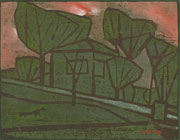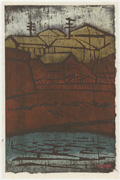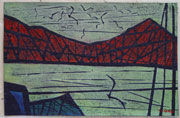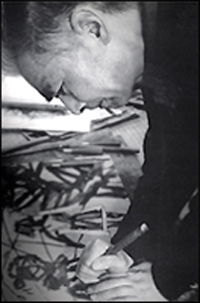Biographical Data
He constantly championed the cause of art for the masses and maintained a close contact in his work with the realities of ordinary life.
Biography
Tadashige Ono (小野 忠重) January 19, 1909 – October 17, 1990Source: Modern Japanese Prints: 1912-1989, Lawrence Smith, British Museum Press, 1994, p. 33 and Guide to Modern Japanese Woodblock Prints: 1900-1975, Helen Merritt, University of Hawaii Press, 1992, p.123.
Ono was born in Tokyo in a then poor district (now called Mukojima), the eldest son of a food and drink shopkeeper. He went to Waseda School of Arts and Crafts in 1921. In 1923 the family house was destroyed in the Great Kanto earthquake. In 1924 he joined a water-colorists’ society called the Tsutaharakai and soon began to study under Okada Saburosuke (1869-1939) at the Hongo Painting Institute (1924-27). He graduated from the department of Japanese and Chinese languages of Hosei University Higher Normal School in 1941.
In 1929 he became active in the proletarian art movement and exhibited at the Proletarian Art Exhibition in Tokyo. His work was heavily influenced by German Expressionism and his woodblocks during this period were mostly monochrome prints issued in small portfolios. In 1932 he co-founded the New Print Group (Shin Hanga Shudan) with Fujimaki Yoshio (1909-1935)1, who Ono acknowledged as his teacher. He reorganized the New Print Group into the Plastic(Formative) Print Association (Zokei Hanga Kyokai) in 1937, as he turned away from overtly politicalwork. In 1936, he exhibited with, and was a member of, the Japan Print Society (Nihon Hanga Kai), but he withdrew from this organization when they refused to accept all members of the Plastic Print Association as members. (For details of his activities during his proletarian art phase and the political climate see "The Dark Valley" below.)
In 1941 he formed his own publishing company, Sorinsha, and he began writing and issuing books on the history of Japanese printmaking. Isolated by the Pacific War, his fortunes reached their lowest point in 1945 with the death of his wife, the second destruction of the family house, a brief period of conscription, and departure to the country where he became a teacher in Tsuyama. Returning to Tokyo in 1946, he worked for a publisher while taking up color printmaking more seriously and developing, from about 1948, his own special technique known as inkoku tashoku-zuri mokuhan (‘color negative woodblock prints’). (See "Technique" below for more detail.) Starting in 1948 he began exhibiting in the Japan Independent Exhibition and continued to do so up to 1983. He was a founding member of the Japan Print Movement Society (Nihon Hanga Undo Kyokai), organized in 1949. In the mid-1950s he became better known, exhibiting at the Tokyo International Print Biennale (1957). He traveled widely in the West in 1961 and participated in an exhibition of modern Japanese prints in the USSR in 1961. He taught at several universities, including Tokyo University of Fine Arts, Aichi University of Fine Arts and Hiroshima University. He exhibited regularly at the College Women’s Association of Japan annual print shows.
Ono is now remembered historically as one of the driving forces behind the sosaku hanga movement, though always a little peripheral to its mainstream. He was a major writer on Japanese graphics, including Modern Japanese Prints (Kindai Nihon no hanga), published in 1971. Smith considers his early proletarian works as derivative, but lauds his later production of color prints (c.1955-75), "with their distinctively glowing palette."
Already popular with a relatively small group of collectors during his lifetime, his reputation has soared after his death, and his work is now in great demand.
1 According to Helen Merritt (Modern JapaneseWoodblock Prints - The Early Years, University of Hawaii Press, 1998, p. 233) Fujimaki's story was a sad one of guilt over family obligations and an obsession to create his art. Intrigued, by Hokusai's life near the Sumida (Tokyo's river), he stopped exhibiting and brooded by the river about creating a long scroll print depicting activities along the Sumida. He eventually disappeared and it is assumed he drowned in the river.
Tadashige Ono and "The Dark Valley"
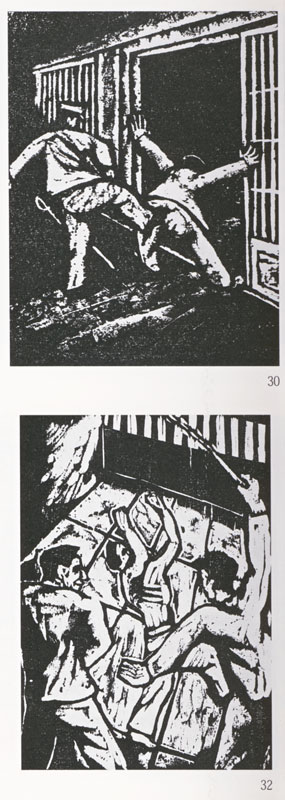 City International Hanga Art Museum, 1993 | Source: Art in the Dark Valley, Louise Tegart, Senior Curator, University Art Gallery, Sydney University Museums News, Issue 14, February 2008 The period between 1930 and 1945 in Japan is often referred to as Kurai tanima – ‘The Dark Valley’ – a period of nationalism and growing conformity. In particular, 1932 is significant in relation to rising patriotism and political repression. It was in 1932 that Japan invaded Manchuria, and also decided to leave the League of Nations. In May of that year, the Japanese system of party government finally crumbled when Prime Minister Inukai Tsuyoshi was assassinated. Japanese printmaking of this period is generally known for the rise of the individual artist/printmaker and the expression of the creative self, as opposed to the production style of printmaking that was typical of earlier ukiyo-e prints. In 1932, Ono Tadashige started a group with a different objective: the Shin Hanga Shûdan (the New Print Group). They wanted to create an outlet for the proletarian art movement, and their motto was ‘prints for the masses’. Shin Hanga Shûdan stood in opposition to Sosaku Hanga Undo (the Creative Print movement), which the group criticized for being too popular in content. The first Shin Hanga Shûdan exhibition was in a Ginza gallery in 1932, and later they also organized street exhibitions to popularize proletarian art. As founding member of the Shin Hanga Shûdan, Ono Tadashige promoted and supported the ideal of art for everyone. Apart from making prints, he contributed significantly to the theory and history of hanga (print), writing handbooks of print techniques and subject matter. The early prints made by the artist, before World War II, were deeply rooted in the social-critical movement of German expressionism, the art trend prevalent in Russia and amongst critical, intellectual circles in China1. In his personal collection, Ono Tadashige had linocuts from the series Prostitutes by the Russian printmaker Pavel Vasilevich Liubarskii. It was this series of linocuts that inspired artists in Shin Hanga Shûdan to use the medium2. Ono Tadashige’s subjects often express social awareness and the isolation and alienation of urban working class life. His technique and style is congruent with his subjects – the early prints were roughly carved, to express the sense that Shin Hanga Shûdan prints were for the masses. Ono Tadashige participated in Proletarian Art exhibitions, where he also worked as a lecturer. The last of the exhibitions he participated in was the fifth in 1932, in which he exhibited fifty works making up the series Sandai No Shi (Three generations of deaths: a novel without words). A complete set of this series is now owned by the University Art Gallery. The prints depict a coal mining family in a small town and the consequences of a tragic accident in the mine, during which the father of the family dies. They represent |
In the 1960s, Ono Tadashige became a visiting professor at a number of Japanese universities, including the Tokyo University of Fine Arts, Aichi University of Fine Arts, Hiroshima University, and Utsunomiya University. He also participated in several international print biennales.
1 Introduction in Modern Boy, Modern Girl – Modernity in Japanese art 1910-1935, John Clark, Art Gallery of NSW, Sydney 1998 p. 23.
2 Hanga – Japanese Creative Prints, Chiaki Ajioka, Art Gallery of NSW, Sydney 2000 p. 59.
Technique
Source: Evolving Techniques in Japanese Woodblock Prints, Gaston Petit and Amadio Arboleda, Kodansha International Ltd.,1977, p. 90.A water-based-pigment technique used by Ono Tadashige, is to darken the paper with bokuju(a liquid form of sumi) first and then size it. Printing the colorover the dark background results in the color being absorbed by theblack. The next step is to print all of the boards using white gouacheover the black background. The artist then proceeds to print with thesame boards using the actual color he desires. Moreover, because thewhite gouache and other pigments also contain size, they are notabsorbed by the black background.
Critique
Source: Contemporary Japanese Prints: Symbols of a Society in Transition, Lawrence Smith, Harper & Row Publishers, 1985, p. 11, 37.Smith describes Ono's style as one which displays "restraint, sobriety and warm, rich color..." He goes on to say: "His work is much concerned with ordinary townscapes and unpretentious landscape, to all of which he adds the special glow of his rich oil-based pigments."
Onchi Koshiro's Critique of the Artist
Source: “The Modern Japanese Print: An Internal History of the Sosaku Hanga Movement,” Koshiro Onchi, appearing in Ukiyo-e Art, A Journal of the Japan Ukiyo-e Society, 1965, p. 18-19.
ONO TADASHIGE (b. 1909) has been a advocate of public art. He was the organizer of the Shin Hanga Shudan and the Zokei Hanga Kyokai, and has exerted many efforts in the field of hanga history. His own style is based on Fauvism. His designs are very strongly printed. Here are two currents of feeling in his work, one a strong feeling for the weird, the other a rather plaintive melodic feeling. Frequently these two strains are harmonized successfully in his prints. He has tried fresh new technical devices and has been consistently active as an experimenter. He tried, for example, applying light color on top of dark colors. He has designed many subjects of street scenes and of crowds of people in public places.
Recent Exhibitions
Source: Tokyo Artbeat website http://www.tokyoartbeat.com/event/2009/8D21.enTadashige Ono "Self Portrait of the Showa Period"
From 2009-10-03 To 2009-11-23At Machida City Museum of Graphic Arts
The work of Tadashige Ono (1909-90) is saturated with human drama and poetic atmosphere. However, his mode of expression cannot be described as something "sentimental". This is because what he attempted to demonstrate on his canvas was the reality of society through the careful observation of the emotions and everyday lives of ordinary people.
Ono also expressed in his work his romanticism and natural affinity for the common man, a critical eye directed at the society he lived in, and even a certain insanity. His work, which emerged out of the eye of an artist who lived through the Showa Period, can be understood as portraits of the Showa era in a universal sense.
Ono also started researching the history of printmaking before WWII, and further devoted himself to this endeavor after the war ended. He unearthed prints from the Edo and Meiji periods and also from China, writing numerous books on Japanese modern printmaking, most of which still enjoy a good reputation.
Commemorating the 100th anniversary of Ono's birth this year, this exhibition showcases a total of 130 representative works by Ono himself, alongside 40 pieces created by print artists who were closely associated with him, as well as his books and related documents. This is a great opportunity for viewers to look back on the Showa period.
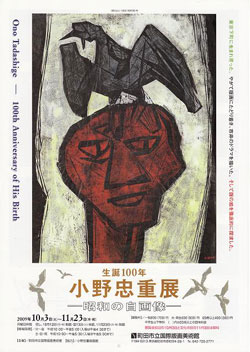 | 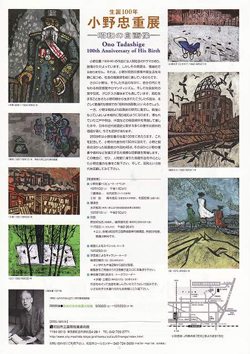 |
Poster from exhibition
